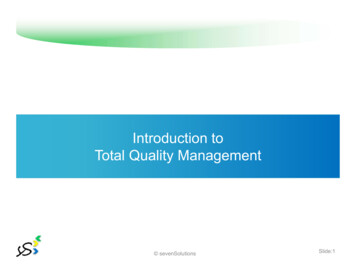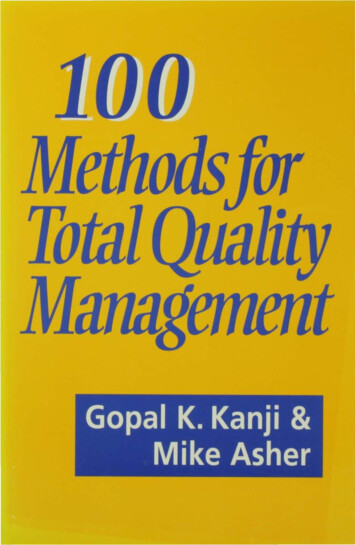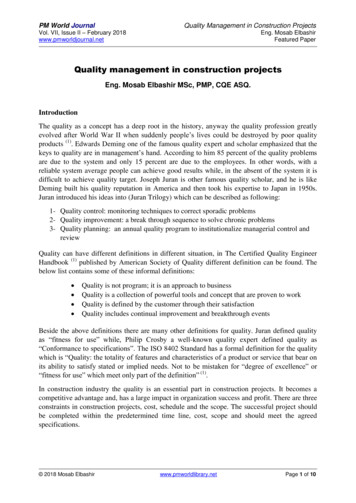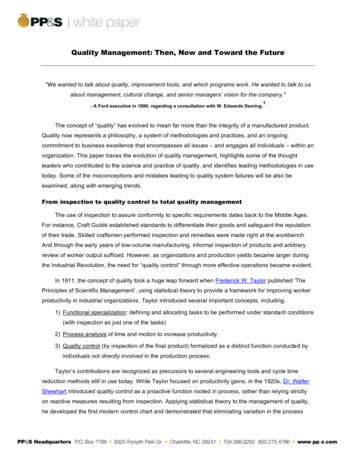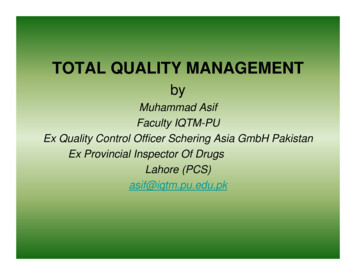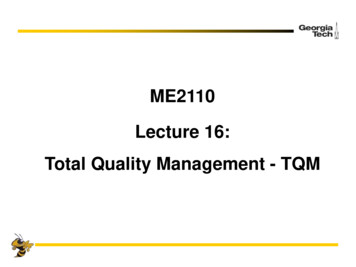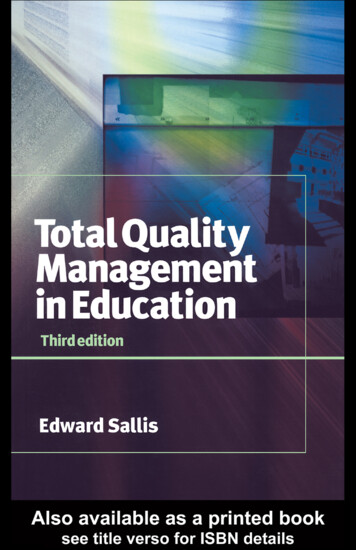
Transcription
Total QualityManagement inEducationThird editionEdward Sallis
For Kate
First published in 1993This edition published in the Taylor & Francis e-Library, 2005.“To purchase your own copy of this or any of Taylor & Francis or Routledge’s collectionof thousands of eBooks please go to www.eBookstore.tandf.co.uk.”Second edition published in 1996Third edition published in 2002Apart from any fair dealing for the purposes of research or private study, orcriticism or review, as permitted under the Copyright, Designs and Patents Act,1988, this publication may only be reproduced, stored or transmitted, in any form,or by any means, with the prior permission in writing of the publishers, or in thecase of reprographic reproduction in accordance with the terms of licences issuedby the Copyright Licensing Agency. Enquiries concerning reproduction outsidethose terms should be sent to the publishers at the undermentioned addresses.Kogan Page Ltd120 Pentonville RoadLondon N1 9JNUKStylus Publishing Inc22883 Quicksilver DriveSterling VA 20166–2012USA Edward Sallis, 1993, 1996, 2002The right of Edward Sallis to be identified as the author of this work has beenasserted by him in accordance with the Copyright, Designs and Patents Act 1988British Library Cataloguing in Publication DataA CIP record for this book is available from the British LibraryISBN 0-203-41701-1 Master e-book ISBNISBN 0-203-44325-X (Adobe eReader Format)ISBN 0 7494 3796 0 (Print Edition)
Contents123The authorixPrefacexBasics1The message of quality1Why quality?2The four quality imperatives3The origins of the quality movement5The contributions of Deming, Shewart and Juran6The growth of interest in quality8Quality11The idea of quality11Quality as an absolute12The relative notion of quality13Two concepts of quality13The consumer’s role in quality15Quality control, quality assurance and totalquality16The educational product18Service quality19Education and its customers21TQM24TQM—some misconceptions24Continuous improvements25
v4567Kaizen26Changing cultures26The upside-down organization27Keeping close to the customers27Internal customers29Internal marketing29Professionalism30The quality of learning30Barriers to introducing TQM31Gurus34W Edwards Deming34Joseph Juran41Philip Crosby—Quality is Free43Tom Peters47Kaoru Ishikawa49Kitemarks51ISO900051Investors in People UK54The Deming Prize (Japan)55The Malcolm Baldrige National Quality Award(United States)56The European Quality Award57Organization60Institutional life-cycle theory60TQM organizations62Lean form, simple structure63Leadership67The educational leader67Communicating a vision68
vi8910The role of the leader in developing a qualityculture69Empowering teachers69Teamwork72The importance of teamwork in education72Teams—the building blocks of quality73Team formation74The effective team76Quality circles78Knowledge80What is knowledge management?80What happens if we ignore our knowledge base?81What is knowledge?82Implications for managers84Sharing knowledge85Communities of knowledge86Knowledge of creation87Learning conversations—learning from tacitknowledge88Knowledge and kaizen90Tools91Brainstorming91Affinity networks92Fishbone or Ishikawa diagrams93Force-field analysis94Process charting94Flowcharts94Pareto analysis95Career-path mapping96
vii11121314Quality function deployment97Benchmarking99What is benchmarking?99Learning from the best100Internal benchmarking102Functional/competitive benchmarking102The educational travel club103Generic benchmarking103How to set up a benchmarking exercise104Planning a benchmarking exercise104The benefits of benchmarking105Are there any drawbacks to benchmarking?106Measurement107Why measure educational quality?107Why value-added?109Budgeting112Linking budgetary delegation to TQM112The neglect of the budgetary dimension113The link between empowerment and delegatedbudgets113How delegated budgets can aid qualityimprovement115Resource allocation models115Links to case-loading116Concluding issues117Strategy118Strategic quality management119Vision, mission, values and goals119Market research122
viii1516SWOT analysis123Moments of truth123The strategic plan124Developing long-term institutional strategies126Business and operating plans127The quality policy and the quality plan128The costs and benefits of quality129The costs of prevention and failure130Monitoring and evaluation130Framework134Quality frameworks134Components of a quality framework135Applying the framework142Self-assessment144What is self-assessment?144Using a self-assessment checklist145Constructing the action plan146The self-assessment quality indicators146The grading scale147Self-Assessing Educational Institutions—aninstrument for self-auditing148Bibliography157Index162
The authorDr Edward Sallis has 30 years’ experience in further and highereducation. He has taught in a wide range of institutions in the UK andJersey. He is Principal and Chief Executive of Highlands College, thefurther further, adult and higher education college of the States of Jerseyin the British Channel Islands.Edward is a specialist in quality management, organizationaldevelopment and strategy and he holds degrees from London,Newcastle and Brunel universities. He is a Fellow of the Institute ofManagement and a Chartered Marketer and gained his PhD from theBristol Business School of the University of the West of England.His many publications include The Machinery of Government (1982);People in Organizations (1989), which he wrote with his wife KateSallis; Total Quality Management (1992), co-authored with Dr PeterHingley; and Knowledge Management in Education (2001), co-authoredwith Dr Gary Jones and also published by Kogan Page. Total QualityManagement in Education was first published in 1993, with a secondedition appearing in 1996. It has since been translated into Chinese.Edward writes regularly for the Channel Islands business magazineBusiness Brief as well as for other educational journals, and he hastaken part in many national and international educational initiatives inthe fields of quality assurance, organizational development, lifelonglearning and the knowledge economy. He is the Director of the BritishIrish Council’s ‘Bridging the Digital Divide’ project and a member ofthe Association of Colleges’ National Policy Forum.
PrefaceWhen the first edition of my book appeared in 1993, quality was a newsubject. My prefaces to the first and second editions of this book wereaimed at persuading sceptical educationalists to embrace total qualitymanagement. I wanted to extol the virtues of TQM and to introduce theworld of education to the then somewhat alien concept of qualityassurance.In the new millennium there is less need to make this call to arms.Quality is nowadays, quite rightly, a high priority and has becomealmost the very stuff of the education debate. But while the novelty mayhave worn off, the need to understand how to assure quality ineducation remains. It is an interesting question whether quality ineducation is really understood.So while many of us may feel that we are now all part of the qualitymovement, there is still a huge gap between the rhetoric and realunderstanding. The philosophies of the pioneers of the qualitymovement, Deming, Juran and Crosby, have not been translated veryaccurately into the practice of education. Do we really believe thatquality is about improving students’ learning, empowering teachers,supporting teamwork, providing leadership or that in pursuit of qualitywe are driving out fear fear in our institutions?Too often today quality has become synonymous with the latestgovernment stricture on standards, examination success, schoolperformance, league tables or part of the latest party politicalpronouncements on education before an election. I do not say this withany sense of cynicism. Rather I sense it is the way of the world. Oncethe message of quality had become popularized, there was always adanger of it becoming vulgarized.One wonders what W Edward Deming, the famous exponent of TQMwho introduced the quality message to the Japanese after World WarII, might have made of some of the initiatives that are today heralded in
xithe name of quality improvement. What might he have made of thesomewhat ruthless regimes of school inspections that countries like theUnited Kingdom have introduced as their response to the need toimprove quality? The third of Deming’s famous 14 points reads ‘ceasedependence on mass inspection to achieve quality’. Thiswill receivehollow laughter from millions of teachers who nowadays await theinspector’s call. This is not to decry inspection per se. Inspection has aplace as a means of verifying self-assessment and as a means of qualitycontrol, but it is not the same as quality improvement, which is a muchgreater task and cannot be externally imposed. Institutions cannot handover the process of improving quality to an external inspector.This new edition has been undertaken because I still believe that totalquality management has a lot to teach education. TQM has taken abattering as the Japanese economy has shown its frailties. But despite theeconomic problems of the Japanese, who first put TQM into action, ithas considerable resilience and much to teach us.TQM as a management model, with its emphasis on leadership,strategy, teamwork, rigorous analysis and self-assessment, has auniversal message. And it has always been a philosophy for the longhaul rather than a short-term fix. It is now required more than ever in ourworld of continuous change.The knowledge revolution has brought about rapid advances intechnology. It has changed the way we work and think and is changinglearning. To cope with the information age every person requires a highstandard of education. High educational attainments are the right ofeach and every child throughout the world. To achieve this every boyand girl needs to have a quality education. This may seem like a pipedream in many parts of the world, or even in the inner city schools ofmany western countries, but this is just the issue where TQM has itsrelevance. TQM in education has as its message the idea that everychild has worth and demands the best possible chance in life. It is anaspiration as relevant in Calcutta or Nairobi as in London, New York orBeijing. It may sound utopian, but it is after all to dreams like these thateducation should aspire, and it was for or dreams like these that thepioneers of TQM, albeit in a different context, developed their ideas.Since the publication of the first edition Total Quality Management inEducation has travelled. It has been sold widely in North America,Africa and Europe and has been translated into Portuguese and Chinese.This edition has brought it up to date and now includes material on thedebates on benchmarking, measurement and value added, knowledgemanagement, quality systems and self-assessment. It now has a sister
xiipublication in Knowledge Management in Education, which I coauthored with Dr Gary Jones. Total Quality Management in Educationwill in all certainty go into further editions as the quality movement ineducation continues to develop throughout the world.
1Basics‘Quality is about passion and pride.’Tom Peters and Nancy Austin, A Passion for ExcellenceQuality is at the top of most agendas and improving quality is probablythe most important task facing any institution. However, despite itsimportance, many people find quality an enigmatic concept. It isperplexing to define and often difficult to measure. One person’s idea ofquality often conflicts with another and, as we are all too aware, no twoexperts ever come to the same conclusion when discussing what makesan excellent school, college or university.The message of qualityWe all know quality when we experience it, but describing andexplaining it is a more difficult task. In our everyday life we usuallytake quality for granted, especially when it is regularly provided. Yet weare all too acutely aware when it is lacking. We often only recognize theimportance of quality when we experience the frustration and timewasting associated with its absence. Of one thing we can be certain:quality is what makes the difference between things being excellent orrun-of-the-mill. Increasingly, quality makes the difference betweensuccess and failure.The best organizations, whether public or private, understand qualityand know its secret. Seeking the source of quality is an important quest.Education is also recognizing the need to pursue it, and to deliver it topupils and students. There are plenty of candidates for the source ofquality in education. Amongst these are: outstanding teachers;
2 TOTAL QUALITY MANAGEMENT IN EDUCATION high moral values;excellent examination results;the support of parents, business and the local community;plentiful resources;the application of the latest technology;strong and purposeful leadership;the care and concern for pupils and students;a well-balanced and challenging curriculum.It is instructive to look to the business world for an insight into quality.IBM’s definition puts it simply: ‘quality equals customer satisfaction’(Unterberger, 1991). Alex Trotman, an Executive Vice-President of theFord Motor Company, has delivered the same message: ‘we know thesedays, in these tough times, that we have to satisfy our customerscompletely’. It is not quite as simple as ‘listen and respond to yourcustomers and all the other good things will follow’, but it is a seriousstart. Organizations who take quality seriously know that much of thesecret of quality stems from listening to and responding sympatheticallyto the needs and wants of their customers and clients. Quality involvesdoing many other things well, but unless an institution puts itscustomers first the preconditions for developing quality will not exist.Why quality?Quality is an idea whose time has come. It is on everyone’s lips. In theUK we have the Citizen’s Charter, the Business Excellence Model andthe Investors in People standard, while the United States has theMalcolm Baldrige Award and the Japanese have the Deming Prize. TheEuropean Foundation for Quality Management has developed thesuccessful European Quality Award, while internationally there is theimportant International Standard ISO9000 series. These are just some ofthe more influential quality awards and standards that have beenintroduced in recent years to promote quality and excellence in a widerange of industries and services. This new consciousness of quality hasnow reached education; educational institutions are being required todevelop their own approaches to quality, and need to demonstratepublicly that they too can deliver a consistent quality service.No longer are quality, quality assurance, total quality and TQM newinitiatives or another set of fads designed to add to the workload ofalready over-worked teachers and under-funded institutions. Whileinitiative fatigue has been a symptom of a hard-pressed education
BASICS 3system for the past decade, quality improvement should not be seen inthis light, but rather as a set of tools to help teachers and educationalmanagers.Total Quality Management is both a philosophy and a methodology.It can assist institutions to manage change and to set their own agendasfor dealing with the plethora of new external pressures. Considerableclaims are made for TQM. There are those in education who believethat TQM properly applied to it can complete a similar transformation.However, TQM does not and will not bring results overnight; neither isit a panacea for all the problems that beset education. Rather it is animportant set of tools that can be employed in the management ofeducational institutions.The four quality imperativesWhen I first started researching quality I asked the question ‘whyshould an educational establishment want to be involved in qualityassurance activities?’ My research has led me to the conclusion thateducational institutions are pursuing quality improvement for a numberof important reasons. Some are linked with professional responsibility,while others result from the competition inherent in educationalmarketplaces or from the need to demonstrate accountability.I have called the results of this research the four quality imperatives.In the commercial world it is the survival imperative that often drivesquality improvement, but the complexity of education and theimportance of values in education makes the motives for taking aquality stance more complicated and diverse. The four imperativesreflect the complex environment in which educational institutionsoperate. They are the drivers and motivating forces that challenge anyinstitution to take a proactive stance on quality.The moral imperativeThe customers and clients of the education service (students, parentsand the community) deserve the best possible quality of education. Thisis the moral high ground in education and one of the few areas ofeducational discussion where there is little dissent. It is the duty ofeducational professionals and administrators to have an overridingconcern to provide the very best possible educational opportunities. AsJohn West-Burnham has put it, ‘it is difficult to conceptualize a
4 TOTAL QUALITY MANAGEMENT IN EDUCATIONsituation where anything less than total quality is perceived as beingappropriate or acceptable for the education of children’.The professional imperativeClosely linked to the moral imperative is the professional imperative.Professionalism implies a commitment to the needs of students and anobligation to meet their needs by employing the most appropriatepedagogic practices. Educators have a professional duty to improve thequality of education and this, of course, places a considerable burden onteachers and administrators to ensure that both classroom practice andthe management of the institution are operating to the highest possiblestandards.The competitive imperativeCompetition is a reality in the world of education. Falling enrolmentscan lead to staff redundancies and ultimately the viability of theinstitution can be under threat. Educationalists can meet the challengeof competition by working to improve the quality of their service and oftheir curriculum delivery mechanisms. The importance of TQM tosurvival is that it is a customer-driven process, focusing on the needs ofclients and providing mechanisms to respond to their needs and wants.Competition requires strategies that clearly differentiate institutionsfrom their competitors. Quality may sometimes be the onlydifferentiating erentiating factor for an institution. Focusing on theneeds of the customer, which is at the heart of quality, is one of themost effective means of facing the competition and surviving.The accountability imperativeSchools and colleges are part of their communities and as such theymust meet the political demands for education to be more accountableand publicly demonstrate the high standards. TQM supports theaccountability imperative by promoting objective and measurableoutcomes of the educational process and provides mechanisms forquality improvement. Quality improvement becomes increasinglyimportant as institutions achieve greater control over their own affairs.Greater freedom has to be matched by greater accountability. Institutionshave to demonstrate that they are able to deliver what is required ofthem.
BASICS 5Failure to meet even one of these imperatives can jeopardizeinstitutional well-being and survival. If institutions fail to provide thebest services they risk losing students who will opt for one of theircompetitors. By regarding these drivers as anything less thanimperatives we risk the integrity of our profession profession and thefuture of our institutions. We are in an era where parents and politiciansare asking tough and uncompromising questions. For education as forindustry, quality improvement is no longer an option, it is a necessity.The origins of the quality movementTo investigate how the quality movement started, we need to understandits origins in industry. It is from industry that the language, conceptsand the methodology of TQM are derived.There has always been a need to ensure that products conform totheir specification and give customer satisfaction and value for money.Achieving consistent quality allows consumers to have confidence in aproduct and its producers. The marks of gold- and silversmiths areevidence of this long-standing concern.Quality assurance became an issue with the advent ofindustrialization. Prior to this craftsmen set and maintained their ownstandards, on which their reputations and livelihoods depended. Theyestablished guilds that regulated quality and developed apprenticeshipprogrammes that ensured that there was proper training and regulationin the craft. The advent of mass-production changed the emphasiscompletely. No longer were individuals responsible for making wholeproducts. Instead the manufacturing process broke down work intonarrow and repetitive tasks. Importantly for our discussion, it took awayfrom the worker the possibility of self-checking quality.One essential feature of a craft, the responsibility of the worker forthe quality of the product, was lost when goods were mass-produced.New production methods, associated with the scientific approach tomanagement and the name of F W Taylor, at the turn of the twentiethcentury, reduced many in the workforce to human components in theprocess of manufacture. A strict division of labour developed from itand necessitated the expansion of a system of detailed inspection knownas quality controlQuality control and inspection are processes that ensure that onlyproducts that meet a pre-determined specification leave the factory gate.However, quality control is an after-the-event process. It is divorcedfrom the people who produce the product. Inspection and quality
6 TOTAL QUALITY MANAGEMENT IN EDUCATIONcontrol are designed to detect defective products. They are necessaryprocesses under mass production, but they are often wasteful andexpensive, involving considerable amounts of scrap and reworking.Quality control and inspection in the past 20 years have increasinglybeen seen as uneconomic and wasteful, as they do not assure that theworkforce care about quality. Many companies are replacing oraugmenting them with methods of quality assurance and qualityimprovement that seek to build quality into the production process byreturning to workers their responsibility for quality.Notions of quality improvement and quality assurance began toemerge after the Second World War. However, in Britain and theUnited States they only began to attract attention on a large scale in the1980s as companies started to ask questions about why the Japanesewere at the time capturing larger and larger shares of world markets in awide range of manufactured products. Questions were asked about theirsuccess, and whether it is bound up with their national culture and theirnovel quality management techniques. To find the origin of this newquality movement we need to start the search in the United States in thelate 1920s.The contributions of Deming, Shewhart and JuranQuality assurance and total quality came late to the West, although theideas were originally developed in the 1930s and 1940s in the UnitedStates by, among others, W Edwards Deming. Deming was anAmerican statistician with a PhD in physics. He was born in 1900 anddied in 1993. His influence as a management theorist has only been ofcomparatively recent origin in the West, although the Japanese havebeen calling on his talents since 1950. He is probably the person whohas done most to influence the quality movement.Deming begun formulating his ideas in the 1930s while working onmethods of removing variability and waste from industrial processes.He started work at Western Electric’s legendary Hawthorne plant inChicago, where Joseph Juran, another pioneering quality theorist andthe other main US contributor to the Japanese quality revolution, wasalso employed. The Hawthorne plant at the time employed over 40,000people manufacturing telephone equipment. It was made famous byElton Mayo and his colleagues from Harvard University, who between1927 and 1932 carried out their famous series of experiments on thecauses of productivity changes. It was whilst there that Mayo and histeam discovered the famous Hawthorne effect. They demonstrated that
BASICS 7the factors that contributed most to increased productivity were notchanges in the physical conditions at work but the style of leadershipand group cohesiveness. In so doing they discovered the importance toindustrial output and productivity of social psychology, group normsand values, leadership and the informal organization structures.After working at Western Electric, Deming moved to the USDepartment of Agriculture. Whilst there he was introduced to a personwho would influence his thinking and introduce him to a number ofideas that were crucial for the development of the quality movement.Walter Shewhart was a statistician who worked at the Bell Laboratoriesin New York. He had developed techniques to bring industrial processesinto what he called statistical control. These were a series of techniquesfor removing the sources of variability from industrial processes, soenabling them to be made more predictable and controllable.Shewhart’s aim was to use statistical control to eliminate waste anddelay. One of Shewhart’s lasting contributions, which was developed byDeming, was his ‘plan, do, check, act’ (PDCA) cycle that offered thefirst method for managing continuous quality improvement.Deming’s initial contribution was to develop and advance Shewhart’smethods. The statistical methods of Shewhart and Deming are nowknown as Statistical Process Control (SPC). Taken together, thecombined insights of the human relations movement associated withMayo and his colleagues and SPC are the theoretical underpinnings ofTQM.The quality movement had its first success following World War II,but not in the United States which had pioneered many of thetechniques. It was in war-ravaged Japan that the quality movementemerged. Deming first visited Japan in the late 1940s to work on theirpost-war census. Impressed by his work, the Japanese Union ofEngineers and Scientists invited him to return in 1950 to lecture toleading Japanese industrialists on the application of Statistical ProcessControl. The Japanese were concerned to reconstruct their war-tornindustry. US bombing had largely destroyed Japanese industry, andwhat was left mainly produced poor-quality imitations of other nations’products. The Japanese wanted to learn the new industrial techniques,particularly the quality control lessons, from other industrializednations.Deming gave his Japanese audiences a simple answer to theirpredicament. He told them not to start with quality control. Instead hetold them to find out what their customers wanted. He suggested to hisaudiences that they design both their methods of production and their
8 TOTAL QUALITY MANAGEMENT IN EDUCATIONproducts to the highest standards to meet customer expectations. Hebelieved that such an approach would enable them to take the lead.Deming believed that his approach, if thoroughly carried out, wouldenable the average company to establish itself as a market leader withinabout five years.The Japanese put into practice the ideas of Deming, Joseph Juran andother US quality experts who visited Japan at the time. The qualitymovement started in manufacturing manufacturing and was followedfollowed by service industries and later by banking and finance. TheJapanese developed the ideas of Juran and Deming into what they callTotal Quality Control (TQC), and used it to capture and create a lion’sshare of world markets in automobiles, electronics and consumerdurables in the 1970s and ‘80s. Much of this market dominance was theresult of the overriding concern for or quality. Their most famousnational writer on quality, Kauro Ishikawa, described the Japaneseapproach to TQC as ‘a thought revolution in management’.The growth of interest in qualityIn their native United States the ideas of Deming and Juran were largelyignored for many years. In the 1950s and ‘60s US business could selleverything they made in a world hungry for manufactured goods. Theemphasis of US and most Western manufacturing industry was onmaximizing output and profit. In the sellers’ market that existed for ortheir goods, quality had a low priority. It was only in the late 1970swhen many of their companies had lost both markets and market shareto the Japanese that a number of major US companies started to takeseriously the quality message. They started asking why it was thatconsumers preferred Japanese products.In the United States, the turning point is often said to have been anationwide NBC documentary in 1980 called If Japan Can, Why Can’tWe. The programme highlighted the dominance of Japanese industry inmany US markets. The latter part of the programme featured W EdwardsDeming and his contribution to Japanese economic success. Since thenthe message of Deming and Joseph Juran, together with other qualityexperts, including Philip B Crosby and Armand V Feigenbaum, hascaught the imagination of business both in the United States and inWestern Europe, although the reality is that only a minority ofcompanies are still seriously implementing TQM. Nevertheless, qualityhas been put firmly on many agendas, although there is a long way to go
BASICS 9Figure 1.1 The chronology of quality developmentbefore TQM becomes the norm as the benchmark for best managementpractice.The quest for the answer to Japanese competition was highlighted inone of the most influential of management texts of the 1980s. Peters andWaterman’s In Search of Excellence was published in 1982. In it theyanal ysed the essential features of the excellent compa
Sallis; Total Quality Management (1992), co-authored with Dr Peter Hingley; and Knowledge Management in Education (2001), co-authored with Dr Gary Jones and also published by Kogan Page. Total Quality Management in Education was first published in 1993, with a second edition appe
